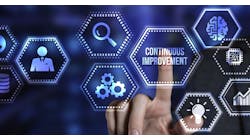Dassault Systemes' Strategy for Speeding up the Auto Industry
Olivier Sappin began his career with Dassault Systemes in 1995, as a body engineer designing for clients including Honda, BMW and Chrysler. But that might as well have been a thousand automotive years ago, harking back to a simpler time when software designers and mechanical engineers kept to their own orbits, dashboards weren’t touch screens and self-driving cars were still science fiction.
“We have evolved a lot,” says Sappin of the 3-D design and Product Lifecycle Management software company (a subsidiary of Dassault Group) that counts most major OEMs among its clients. “We used to be covering mechanical engineering, but now we are doing systems, we are doing software, we are doing sales and marketing.”
Sappin talked to IndustryWeek about what’s ahead for Dassault Systemes, and where he sees automotive design and manufacturing heading (very quickly).
Dassault Systemes has been on an acquisitions tear in the past five years, buying up manufacturing and engineering technology companies. What’s the strategy there?
We worked so many years with mechanical and systems engineers. We were providing our solutions for experts, and they were using our software to design every single system of a car in a virtual environment. But the more we worked with them, the more we found that in the overall innovation process, engineering is involved—but so are safety people, sales people, marketing people.
So we started to invest in technology in order to extend our footprint, and to provide the opportune environment for basically the entire company and put that on a platform.
The critical path for us was really business transformation. Ever single carmaker and supplier has had to reinvent themselves. They have to think about providing not only product but the full experience for the customer. We said if we want to make sure that the customer understands how to use our technology, we need to speak the language of many different industries.
And you need do it quickly to stay technologically relevant.
Yes, exactly. It could be things to optimize the existing process. You take a big automotive company. They have 10,000 engineers because it’s quite complex to do a car. You have powertrain components and systems; you have body components and systems, so the entry barriers to entering this sector are very high. These are complex engineering things. It’s also complex in terms of putting a car on the market. If an engineer thinks of a great idea, that idea may become reality maybe at best in two years, at worst in five.
And you look at the system expectation--consumers don’t want to wait for that. They want the design cycle to be what you can find on your smartphone. You want to download apps from your car like you download apps from your phone, and I think only a car company like Tesla can do that right now. So it means there is a real, constant objective in the automotive sector to automate things, to make sure they can be even more reactive to the changing customer expectation. And they need to make sure that they can automate a lot of the activity. So this is what we do with one side---automating and coding and reducing cycle time.
We also need also to disrupt. Not only making things, but completely changing the model.
How are advancements in 3-D visualization changing the way cars are designed and built?
There is a lot happening at the moment. First of all, if you look from a pure automotive market, everybody is talking about the autonomous car, connected car, new mobility. This is clearly impacting us because fundamentally, the objective our customers need to achieve might be completely different a few years from now. Or maybe you are a new company that has nothing to do with automotive and are creating a new car concept.
We see three areas where we can compete. One is providing a collaboration platform for engineers. We think that this platform needs to be social. Because today, most collaboration platforms are mainly for experts. But if you really want to bring breakthroughs like the autonomous car, the connected car, you need to connect people who are coming from different environments. People doing engineering and software normally might not connect. Or maybe the marketing guy the engineering guy might not connect, or the engineers wouldn’t connect to the ideas of the consumers on the internet.
Handling Complexity
The second area is mastering the system complexities. Whenever you develop a smart car, you need to make sure that every engineer can design and simulate the system. So we have critical technology to simulate the system.
In your car, for example, you have an electronic control unit which is the brain of the car which will send a signal to every different system. And then you have a lot of smart controls that you need to tune. You need to validate every kind of scenario even before the car physically exists. So you need to make a virtual simulation of the entire car.
For example, BMW is designing an electric car. We had to check the battery and the electric motor. You run on a traditional driving cycle in the city, you need to determine how much heat will be in the battery so that you can see how different elements behave. Then you can tune the overall architecture of the system to avoid any problems of overheating in your internal components. This is typically the kind of simulation that carmakers want to do.
And as cars are becoming connected, the third area is analyzing all the data that the car’s sensors collect. I’ll give you one pragmatic example. Recently, we made an exercise for one customer to index all the data coming from NHTSA. It comes in a bit unstructured, so it needs indexing. And we have a so-called semantic search in order to easily find all the issues related to one topic.
Basically, what we’re trying to do is correlate the data coming from NHTSA with the client’s own database. For example, if I am a supplier, and I want to know on all cars which use my system what kind of problems NHTSA has discovered, I can easily get the data in a way that it will become a kind of dashboard for the engineer to learn in advance about issues that will happen later. We want to do predictive maintenance--predict what kind of issue they will have in the future, a few days, a few months.
I think the engineer of the future will have to work from that collected data. All the design, all the simulation can be greatly important if he can understand exactly how the product is behaving in real life.
How is the automotive production process changing with this new technology?
To understand the disruption in technology, you have to think about this: A car is an amazingly complex product in terms of technology. Yet everything hinges on making this car at an affordable price. This is what differentiates the automotive sector from any other sector. The price of the car itself and every single component is ridiculously low. Everything is made so that people are doing 2 million cars, 3 million cars, 5 million cars, and trying to do economy of scale so you can do every single component at a minimum. This is where we are today.
In the future, we may have an issue with that model. The problem is that the consumer expectation is changing so quickly that you need to adapt. You need to be much more flexible. And flexible in a way that you might need to be able to reconfigure a line completely to do a different operation in order to meet consumer demand. If we want to do that, we need to rethink a lot of things. We need much more collaboration to make sure that you can relay the different product data easily to check different solutions and react quickly.
Here’s an example. With lean, you know exactly how the car will be built, how many things will be assembled in which order, so everything is planned in advance and everything is optimized as much as possible. Now if you stop to think about changing everything at the last moment because the customer wants something different, you need to plan things in a totally different way. This is why you need much more integration between engineering and manufacturing. It’s key that the different execution systems of the plant will become much more connected, much more sophisticated.





